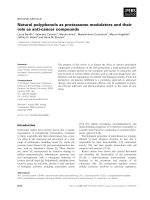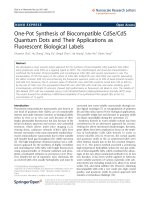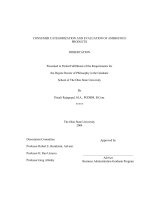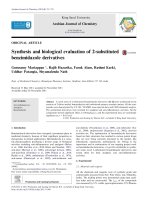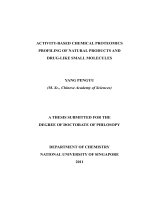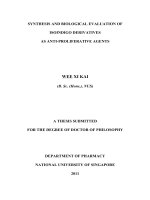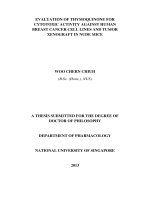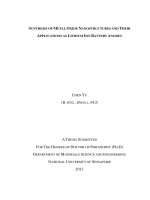Synthesis and biological evaluation of natural products and their analogs as new cancer chemotherapeutic agents
Bạn đang xem bản rút gọn của tài liệu. Xem và tải ngay bản đầy đủ của tài liệu tại đây (977.24 KB, 165 trang )
SYNTHESIS AND BIOLOGICAL EVALUATION OF
NATURAL PRODUCTS AND THEIR ANALOGS AS
NEW CANCER CHEMOTHERAPEUTIC AGENTS
FANG ZHANXIONG
NATIONAL UNIVERSITY OF SINGAPORE
2010
SYNTHESIS AND BIOLOGICAL EVALUATION OF
NATURAL PRODUCTS AND THEIR ANALOGS AS
NEW CANCER CHEMOTHERAPEUTIC AGENTS
FANG ZHANXIONG
(B.Sc.(Hons.) NUS)
A THESIS SUBMITTED FOR THE DEGREE OF
DOCTOR OF PHILOSOPHY
DEPARTMENT OF CHEMISTRY
NATIONAL UNIVERSITY OF SINGAPORE
2010
i
ACKNOWLEDGEMENTS
I would like to express my sincere gratitude to my supervisor A/P Lam
Yulin who has always given me valuable input and advice throughout my
studies. She has always been patient and understanding in giving me time to
surmount some of the difficulties I encountered over the course of my research.
I would also like to thank Prof Wu Shih-Hsiung, Dr Hua Kuo-Feng, Dr
Yang Yu-Liang and Dr Chen Yi-Lin as the bulk of my research presented in
this thesis was the result of a successful collaboration with them. They have
provided valuable ideas and are responsible for the biological studies discussed
in this thesis.
To all my past and present group members, Dr Fu Han, Dr Kong Kah Hoe,
Dr He Rongjun, Dr Gao Yongnian, Dr Soh Chai Hoon, Dr Gao Yaojun, Che
Jun, Ching Shimin, Wong Lingkai, Lin Xijie, Sanjay Samantha, Woen Susanto,
Hadhi Wijaya, Tan Chong Kiat and Fung Fun Man, thank you for the advice
and assistance that you have given me. Also thank you for making the
laboratory a lively place and I enjoy your company.
I would like to express my appreciation to CMMAC staff for their
assistance in the characterization of the compounds in this thesis.
To Mdm Toh Soh Lian, Tan Lay San and Au Pei Wen, thank you for help in
the use of the hydrogenation vessel in the Applied Chemistry Laboratory.
Finally, I would like to thank my friends and family for their unwavering
support during these four years.
ii
TABLE OF CONTENTS
TABLE OF CONTENTS ii
SUMMARY iv
LIST OF TABLES vi
LIST OF FIGURES vii
LIST OF SCHEMES ix
LIST OF ABBREVIATIONS x
Chapter 1: Introduction
1.1.1 Overview of Cancer 1
1.1.2 Cancer as an Evolutionary Process 3
1.1.3 Molecular Causes of Cancer 3
1.1.4 Environmental Causes of Cancer 5
1.1.5 Cancer Treatment: Chemotherapy Past & Present 9
1.2.1 Natural Products as Medicine 13
1.2.2 Anticancer Drugs from Plants 13
1.2.3 Microbes as Sources of Antitumor Agents 14
1.2.4 Anticancer Drugs from Marine Sources 16
1.2.5 Synthesis of Natural Products 17
1.2.6 Semisynthesis and Total Synthesis of Natural Products 18
1.2.7 Combinatorial Synthesis Based on Natural Products 20
1.3 Purpose of the Research Work in this Thesis 22
1.4 References 22
Chapter 2: Synthesis and Biological Evaluation of Polyenylpyrrole
Derivatives as Anti-cancer Agents
2.1 Introduction 29
2.2 Results and Discussion
iii
2.2.1 Retrosynthesis 32
2.2.2 Synthesis of Compounds 2-2 33
2.2.3 Synthesis of Fluorescent Tags 38
2.2.4 Synthesis of Compounds 2-4 41
2.2.5 Synthesis of Compounds 2-1 45
2.3 Biological Results 48
2.4 Conclusion 52
2.5 Experimental Section 52
2.6 References 108
Chapter 3: Synthesis and Biological Evaluation of Lignan Natural
Products as Potential Chemotherapeutic Agents
3.1 Introduction 112
3.2 Results and Discussion 116
3.3 Biological Results 126
3.4 Conclusion 123
3.5 Experimental Section 123
3.6 References 131
Chapter 4: A Rapid and Convenient Synthesis of 5-Unsubstituted
3,4-Dihydropyrimidin-2-ones and thiones
4.1 Introduction 134
4.2 Results and Discussion 135
4.3 Conclusion 139
4.4 Experimental Section 141
4.5 References 149
iv
SUMMARY
Cancer is a leading cause of death in the world and there is a continual
search for new anti cancer drugs. Today, more than half of the clinically
available drugs are either natural products or derived from natural products.
This is not surprising as natural products have been used for centuries as
medicine and it is clear that Nature will continue to be a source for many new
drug leads. The use of natural product scaffolds to synthesize analogs has
already produced many new drugs for cancer chemotherapy. Here the aim of
this thesis is to develop different classes of natural product analogs as potential
new chemotherapeutic agents.
In Chapter 2, we described the first reported synthesis of a class of
polyenylpyrrole natural products and their analogs. The compounds were
evaluated for the cell cytotoxicity against human lung cancer cells A549 and
structure-activity studies showed that the 3-chloropyrrole moiety is essential as
replacement of the group with other 2 or 3-chloro aromatic rings led to a
complete loss of activity. 2 of these compounds displayed excellent
cytotoxicity with IC
50
of 0.6 µM and 0.01 µM respectively. In addition, these 2
compounds proved to be non-toxic to normal human lung cells Beas-2b at up
to 80 µM. These results indicated that these 2 compounds have the potential to
be developed as anticancer agents due to their high selectivity against A549
cells.
In Chapter 3, the synthesis of lignan natural products as potential anti-tumor
agents was described. After the synthesis of racemic isochaihulactone and
v
nemerosin was achieved, asymmetric synthetic technique was introduced to
afford all 4 lignan isomers: isochaihulactone, slyvestrin, nemerosin and its
enantiomer. Of these 4 compounds synthesized, isochaihulactone and
slyvestrin are natural products which had been isolated previously but never
synthesized. Nemerosin is a natural product which had previously been
synthesized while there are no reports on the isolation or synthesis of the
enantiomer of nemerosin. Both isochaihulactone and slyvestrin displayed
cytotoxicity against various cancer cells.
Chapter 4 described the microwave assisted synthesis of 5-unsubstituted
3,4-dihydropyrimidin-2-ones and thiones through a modified Biginelli
procedure. Under microwave irradiation, the reaction time was shortened from
12 h to 15 min. These results further demonstrate the value of microwave-
assisted synthesis in increasing yield, shortening reaction time and streamlining
high throughput synthesis. This also represents the first reported synthesis of
such a class of 5-unsubstituted 3,4-dihydropyrimidin-2-thiones.
vi
LIST OF TABLES
Table 1.1
Leading causes of death in the United States, 2007
(thousands)
2
Table 1.2
US cancer deaths that would be avoided by removing
known risks
6
Table 2.1
Analogs of 2-7 and 2-8 synthesized 35
Table 2.2
Analogs of 2-9 and 2-10 synthesized 36
Table 2.3
Analogs of 2-2 synthesized 37
Table 2.4
Analogs of 2-4 synthesized 45
Table 2.5
Analogs of 2-30 synthesized 47
Table 2.6
Cytotoxicity of conjugated polyenes against human lung
cancer A549 cells
48
Table 3.1
Optimization of the synthesis of 3-4 119
Table 3.2
Cytotoxicity of synthesized compounds against various
cancer cells
122
Table 4.1
Optimization of the synthesis of 4-7a 137
Table 4.2
List of compounds synthesized 139
vii
LIST OF FIGURES
Figure 1.1
All malignant neoplasms incidence rate by age group 4
Figure 1.2
Probability of death from lung cancer in the United
States, 1984-1991
8
Figure 1.3
Number of approval of new drugs for cancer by FDA 11
Figure 1.4
Selected drugs used in cancer chemotherapy 12
Figure 1.5
Chemotherapeutic drugs developed from plant sources 14
Figure 1.6
Anticancer agents from microbial organisms 15
Figure 1.7
Marine sources derived anticancer drugs 17
Figure 1.8
Synthesis of paclitaxel from 10-deacetylbaccatin III 19
Figure 1.9
Structural similarities between halichondrin B and
eribulin
20
Figure 1.10
Natural product-based combinatorial synthesis 21
Figure 2.1
Examples of conjugated polyenes with biological
activity
30
Figure 2.2
Structures of auxarconjugatin, 12E-isorumbrin and
related polyenes
32
Figure 2.3
Commonly used fluorescent tags 39
Figure 2.4
Compounds 2-1a and 2-1l were non-cytotoxic to normal
human lung cells
51
Figure 3.1
Classes of lignan compounds 112
Figure 3.2
Lignan-derived anticancer drugs 113
Figure 3.3
Lignans with antitumor properties 113
Figure 3.4
Natural products isolated from the root of Bupleurum
scorzonerifolium
115
Figure 3.5
Compounds synthesized 117
Figure 3.6
Structure of itaconic acid 3-13a, its dimethyl derivative
3-13b and ligands used for asymmetric hydrogenation
120
viii
Figure 4.1
Structures of (S)-monastrol and its analogs as inhibitors
of kinase Eg5
135
Figure 4.2
Pyrimidi-2-thione 4-2 and pyrimidin-2-one 4-3 with
sodium channel blockage ability
136
Figure 4.3
X-ray crystal structure of 4-7w 139
ix
LIST OF SCHEMES
Scheme 2.1
Retrosynthesis of auxarconjugatin and its analogs 2-1 33
Scheme 2.2
Preparation of compound 2-7e 33
Scheme 2.3
Preparation of compounds 2-2(a-s) 34
Scheme 2.4
Synthesis of dansyl tags 39
Scheme 2.5
Synthesis of 2-2t and 2-2u 41
Scheme 2.6
Synthesis of 2-4(a-d) 43
Scheme 2.7
Synthesis of 2-29 44
Scheme 2.8
Synthesis of 2-1 46
Scheme 3.1
Asymmetric hydrogenation step of the Monsanto
L
-
DOPA process
116
Scheme 3.2
Preparation of 3-4 and 3-5 118
Scheme 3.3
Asymmetric synthesis of 3-4 and 3-5 121
Scheme 4.1
The Biginelli reaction 134
Scheme 4.2
Modified Biginelli reaction 136
x
LIST OF ABBREVIATIONS
AcOH acetic acid
Apaf-1 apoptotic protease activating factor 1
aq aqueous
BCR-ABL breakpoint cluster region-abelson
Bn benzyl
Boc tert-butoxycarbonyl
Bu butyl
COD cycloocta-1,5-diene
dba dibenzylideneacetone
DBU 1,8-Diazabicyclo[5.4.0]undec-7-ene
DIBAL diisobutylaluminium hydride
DMAP 4-Dimethylaminopyridine
DMF N-N-dimethylformamide
DMP Dess-Martin periodinane
DMSO dimethylsulfoxide
DTS diverted total synthesis
ee enantiomeric excess
xi
EGFR epidermal growth factor receptor
EI electron impact
ESI electron spray ionization
Et ethyl
Et
2
O diethylether
EtOAc ethyl acetate
Fas apoptosis stimulating fragment
FDA Food and Drug Administration
HPLC high performance liquid chromatography
HRMS high resolution mass spectroscopy
IBX 2-iodoxybenzoic acid
KIT c-kit protein
L
-DOPA
L
-3,4-dihydroxyphenylalanine
LCMS-IT-TOF liquid chromatography mass spectrometer-ion trap-time of
flight
LDA lithium diisopropylamine
Me methyl
Ms methanesulfonyl
NBD-Cl 4-chloro-7-nitrobenzooxadiazole chloride
xii
NCS N-chlorosuccinimide
NMP N-methylpyrrolidone
NMR nuclear magnetic resonance
PARP poly (ADP-ribose) polymerase
PMA phosphomolybdic acid
Ph phenyl
PMA phosphomolybdic acid
TBAF tetrabutylammonium fluoride
TEA triethylamine
TFA trifluoroacetic acid
THF tetrahydrofuran
TLC thin-layer chromatography
TMS tetramethylsilane
TNF tumor-necrosis factor
UV ultraviolet
1
Chapter 1: Introduction
1.1.1 Overview of Cancer
Cancer is a leading cause of death in the world and in the United States,
about 23% of all human deaths can be attributed to it (Table 1.1)
1
. Cancer
affects people of all age groups though the risk of most types of cancer
increases with age. Although the many stages of carcinogenesis depend on
environmental and other non-genetic factors, it is generally accepted that
cancer arises from mutation in genes.
2-5
Cancer cells are defined by two
heritable characteristics:
6
1. They and their offspring reproduce with disregard for the normal restraints
on cell division.
2. They invade and occupy areas normally meant for other cells.
The combination of these two traits makes cancer especially dangerous. A
cell, regardless of how destructive it may be, cannot cause significant damage
if it is isolated and does not proliferate faster than its normal neighbor.
However when the cell proliferation is uncontrollable, it will lead to the
formation of a tumor or neoplasm. A neoplasm is essentially a persisting
growing mass of abnormal cell. If the cells are unable to invade other tissue,
the tumor is said to be benign. Here, a complete cure can typically be achieved
by removing the tumor surgically.
7
A tumor is only considered cancerous or
malignant if the cells acquire the ability to invade surrounding tissue. This
invasion and formation of secondary tumors at other sites of the body by the
original cancer cells is known as metastasis.
2
Table 1.1. Leading causes of death in the United States, 2007 (thousands)
1
Deaths %
Heart diseases 616 25.4
Malignant neoplasms 563 23.2
Cerebrovascular diseases 136 5.6
Lower respiratory infections 128 5.3
Accidents 124 5.1
Alzheimer’s disease 75 3.1
Diabetes mellitus 71 2.9
Influenza and pneumonia 53 2.2
Nephritis, nephrotic syndrome 46 1.9
Septicemia 35 1.4
Sucide 35 1.4
Liver diease and cirrhosis 29 1.2
Hypertension and hypertensive renal disease 24 1.0
Parkinson’s disease 20 0.8
Cancers are classified based on the tissue and cell type they originated from.
Cancers arising from muscle cells or connective tissues are known as sarcomas
3
while those arising from epithelial cells are called carcinomas. There are also
cancers that do not belong to these two categories and these include leukemia
and cancer of the nervous system.
6
1.1.2 Cancer as an Evolutionary Process
From an evolutionary perspective, a neoplasm can be viewed as a large
population of genetically and epigenetically heterogeneous cells.
8
Via natural
selection, neoplastic cells will undergo genetic and epigenetic modifications
that are beneficial to them. Evolution of neoplastic cells is determined by their
interaction with its environment and other cells. This interaction includes
attempts at treating or preventing cancer. Evolution of the cancer cell generally
leads to faster proliferation and metastasis as well as greater drug resistance.
Evidence of this can be observed by the resistance of mutant lung cancer cells
to anilinoquinazoline EGFR inhibitors.
9
Chronic myeloid leukemia and
colorectal cancer have also been found to develop resistance to imatinib and 5-
fluorouracil respectively.
10,11
1.1.3 Molecular Causes of Cancer
At the molecular level, cancer results from the mutation of cancer-
susceptible genes. These genes belong to one of 3 classes:
12,13
gatekeepers,
caretakers and landscapers. Gatekeepers consist of oncogenes and tumor-
supressor genes and they control the growth and differentiation pathways of the
cell. The function of the caretakers is to maintain the genomic integrity of the
cell.
14,15
A mutation of the caretakers can result in genetic instability which in
turn can lead to rapid mutation of the genes that directly control cell birth and
4
death. Landscapers are named as such because they create an abnormal stromal
environment that leads to the neoplastic transformation of cells.
16
Despite cancer being a result of gene mutation, a single mutation is not
sufficient to give rise to cancer. For full-blown cancer to develop several
independent and rare mutations would have to occur.
17,18
As such, the risk of
cancer development depends not only on the initial mutation but also on
successive mutations driving cancer progression. One indication of this comes
from the study of the incidence of cancer as a function of age. If cancer is
caused by a single mutation occurring with a fixed possibility per year, the
incidence of cancer should be independent of age. However the development of
cancer rises steeply with age (Figure 1.1).
19
This is in line with the fact that
cancer is caused by an accumulation of numerous random mutations in the cell
line.
Figure 1.1. All malignant neoplasms incidence rate by age group.
5
1.1.4 Environment Causes of Cancer
Due to the inherent limitations in the accuracy of DNA replication, gene
mutations and consequently cancer can never be completely avoided. If a
person is to live long enough, the cell would eventually undergo sufficient
mutations for cancer to develop. That said, evidence indicates that
environmental factors play a role in the development of most types of cancer.
This can be most clearly seen by comparing the cancer incidence rates in
different countries. Many types of cancer vary in incidence between different
countries and a cancer that is common in one country might be rare in
another.
20
The convergence of cancer incidence among immigrants toward that
of the local population also points to the influence of the environment rather
than genetic factors. By the 1960s, the World Health Organization concluded
that most cancers should be avoidable or at least delayed based on environment
or lifestyle choices (Table 1.2).
21
The most significant environmental cause of cancer in the world today is
tobacco. The risk of lung cancer is the highest among those who smoke at a
young age and continue to do so thereafter (Figure 1.2).
22
This is because lung
cancer incidence increases rapidly for continuing smokers. In Britain, the large
increase in male smokers during the First World War led to an unprecedented
rise in lung cancer incidence some forty years later.
23
This pattern was repeated
in the United States during the Second World War.
20
Since then, after tobacco
was proven to be a carcinogen, smoking has been declining steadily especially
in Britain and as such, lung cancer incidence has fallen as well.
21,24
In China,
however, the rise in the number of smokers over the past two decades has led
6
to an increase in mortality from lung cancer.
25
The carcinogenic effects of
tobacco extend beyond the lung and include the stomach, liver, mouth,
esophagus, pharynx, pancreas, bladder and kidney.
25,26
Table 1.2. US cancer deaths that would be avoided by removing known risks.
21
Cause Deaths avoided (%) after removing preceding
cause
Smokers Non-smokers
Smoking 60 -
Known infection 2 5
Alcohol 0.4 1
Sunlight 0.4 1
Air pollution 0.4 1
Occupation 0.4 1
Lack of exercise 0.4 1
BMI > 25 kg m
-2
4 10
Dietary factors 4~12 10~30
Presently unavoidable About 25 At least 50
7
Another important environment cause of cancer would be diet. However it
is exceedingly difficult to identify how a diet affects the incidence of cancer
due to the vast variety of food and the patterns of consumption. Only the data
collected from the consumption of excessive alcohol and food contaminated
with aflatoxin B1 are sufficient to establish these two as significant
carcinogens.
27
Aflatoxin B1 is a fungus that grows on food such as peanut and
is an important cause of cancer in Africa and Asia. The only way to determine
if a particular food item is deemed cancer-preventive and cancer-causing is to
conduct large randomized trials that continue for many years. However the
following example highlights the difficulties in obtaining conclusive results
even with such a trial. There had been substantial evidence suggesting that
food rich in beta-carotene can reduce the risk of lung cancer.
28
However a large
randomized trial showed no benefits after 12 years of treatment.
29
Moreover
two shorter trials showed that lung cancer risk was higher among those who
received beta-carotene supplements.
30
Despite these conflicting data, one result
that most cancer epidemiologist would agree upon is that obesity can lead to an
increase in cancer risk.
31
8
Figure 1.2. Probability of death from lung cancer in the United States, 1984-
1991.
1
About 15% of cancers in the world could be due to bacteria, viruses and
parasites.
32
Chronic infection with bacteria or parasites may lead to the
development of cancer. Helicobater pylori, which can cause chronic bacterial
infection, is known to be a major cause of stomach cancer.
33
Liver cancer is
common in Africa and Southeast Asia and this coincides with the higher
incidence of hepatitis-B infection.
34
In fact in these areas, liver cancer occurs
almost exclusively in patients who had been diagnosed with hepatitis-B
infection.
21
Another small proportion of cancer today can be due to environmental
pollutants and occupational exposure to certain hazards. In the past, the lack of
knowledge of certain chemicals carcinogenic effects led to workers developing
cancer as a result of overexposure to such carcinogens. A classic example
occurred in the early 1900s when all the male workers who were distilling 2-
9
napthylamine in a British factory eventually developed bladder cancer.
35
A
more recent example was the mesothelioma epidemic in the 1990s. This arose
from the widespread use of asbestos from the 1950s to 1970s but due to the
long latency of the disease, the patients showed symptoms of the disease only
decades later. Even today incidence of mesothelioma is still rising due to
exposure to asbestos in the 1970s and 1980s.
36
By late 1970s, exposure limits
for several industrial hazards have been reduced in many Western countries
and it is believed that current occupational exposure levels would have a
minimum impact on cancer incidence.
20
1.1.5 Cancer Treatment: Chemotherapy Past & Present
One of the oldest descriptions of cancer is in the Ebers papyrus which dates
back to about 1600 B.C. and it suggests cauterization for the treatment of
tumor.
37
Since then mankind has come a long way in the understanding and
treatment of cancer. Still, of the diseases that have plagued mankind, none
have been more hard-fought than that against cancer. The treatment of a
cancer has been likened to the removal of weeds in a garden. The cancer cells
can be removed surgically or destroyed using radiation or chemicals but it is
difficult to eliminate every one of them. The few cells that remain can
proliferate again resulting in a relapse.
6
Moreover they may evolve resistance
to the chemicals or radiation that was used previously. Before 1950, treatment
of cancer mainly involved the removal of the tumor surgically. Radiation
oncology proved to be effective for the control of localized tumor after 1960s
but the drawback back then was radiation therapy, like surgery, could not treat
10
metastatic cancer.
37
Chemotherapy has thus become the focus for the treatment
of cancer.
The beginning of effective chemotherapy dates back to World War I when
autopsy findings of soldiers who died from sulphur mustard poisoning revealed
that these victims had severe lymphoid hypoplasia and myelosuppression.
38
This led to the development of nitrogen mustard which was tested on a mouse
with Gardner lymphosarcoma. The drug was surprisingly effective and the
tumor began to regress after two injections. Although the tumor recurred, the
mouse lived for 84 days when three weeks was the average survival period for
a mouse with this tumor.
39
This eventually resulted in the trial on a man who
was suffering from terminal stages of lymphosarcoma which radiation therapy
failed to treat.
40
Treatment with nitrogen mustard caused the tumor to regress
and although the remission lasted only a few weeks, it was the first concrete
evidence that chemicals could be used to induce tumor suppression.
In 1956, Gordon Zubrod was appointed the head of the Division of Cancer
Treatment in the United States. He had a strong interest in natural products and
spearheaded a program for the collection and testing of plants and marine
sources.
40
This led to the discovery of taxanes and camptothecins. Both classes
of compounds encountered significant difficulties during development but
eventually, paclitaxel was marketed by Bristol Myers Squibb as Taxol in 1991
and it became the first billion dollar per year drug (Figure 1.4).
41
As for
camptothecin, its semi-synthetic analogue, irinotecan, finally won approval
from the Food and Drug Administration (FDA) in 1996.
42
Today, paclitaxel is
11
used primarily to treat lung and ovarian cancer while irinotecan is used for
colon, lung and ovarian cancer.
43
0
5
10
15
20
25
30
No. of
Approvals
1971-
1975
1976-
1980
1981-
1985
1986-
1990
1991-
1995
1996-
2000
2001-
2005
Figure 1.3. Number of approval of new drugs for cancer by FDA.
40
Despite the development of new cancer drugs such as cisplatin and
fludarabine, by the 1980s, cancer chemotherapy appeared to have slow down
(Figure 1.3).
44,45
One of the main reasons is the failure of animal models to
accurately predict the pharmacokinetics of cancer drugs in human.
40
Moreover
cancer drug discovery requires long-term trials which often yield marginal
gains. These gave cancer drug discovery a reputation for having high risks with
minimal rewards. All of these changed with the advancement of cell biology at
the molecular and genetic levels. New signaling networks that regulate cell
survival and proliferation were discovered and many of these were
significantly different in cancer cells. Small biotechnology firms sprang up as
researchers attempted to fix these molecular defects in cancer cells. This
heralded the beginning of the targeted-therapy era. One of the most significant
